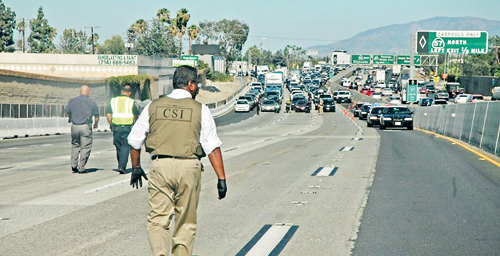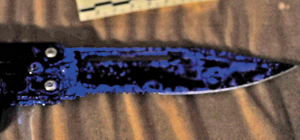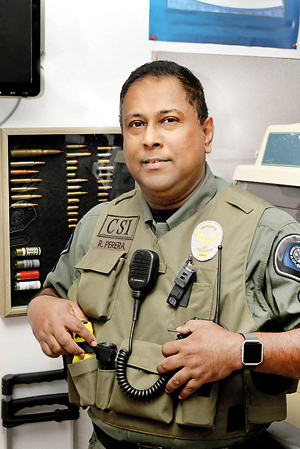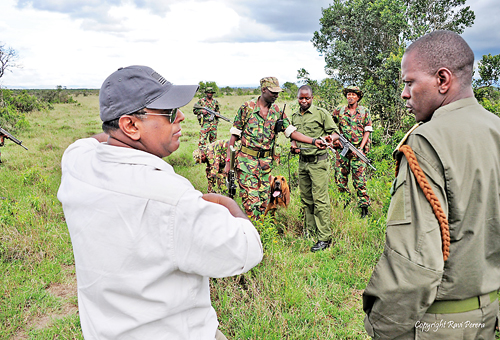Crime busting in the US

Freeway shooting: All traffic was stopped during rush hour so that the CSI team could look for a handgun that the bad guy tossed out of his vehicle after he shot someone
The house was the launching pad for a spree of crimes. The suspects who had rented it out using fake names had fled but armed with a search warrant the Crime Scene Investigators (CSIs) were running the house through a fine-tooth comb when they found a camera.
In the pictures, there were no faces, one of the CSIs found, on reviewing the camera. The pictures were mostly of electrical wiring. But one, just one picture had a finger pointing to a wire.
Skill, long hours and sophisticated software kicked in to help enhance the finger to obtain enough ridge details to convert it into a fingerprint. A search through the database and voila the fingerprint was of a ‘wanted’ person, in connection with several serious crimes including kidnappings and carjackings.
That finger in a photograph led to the man’s arrest a few weeks later…….and the CSI who helped crack the case across the seas in the United States of America (USA) is 57-year-old Ravi Perera attached to the Forensic Academy of the Federal Bureau of Investigation (FBI) in Quantico, Virginia.

Even if a knife has been used in a stabbing and wiped clean, blood can be detected (luminous blue and special lighting in the lab) on it and used as evidence
Ravi is a CSI going into his 25th year of such work this month and when he applied to join the FBI’s Forensic Academy he had been the only CSI selected from California and one of just 12 from the whole of the US.
“Some of the equipment we use is so sophisticated that it puts James Bond to shame!” he says, adding, however, that he cannot really talk about this as the information is classified.
Gripping as well as chilling are the many crime scene investigation television series of American origin beamed into our sitting rooms, riveting our attention and making sure that we miss not a single episode.
In those we see the all-too-familiar yellow tape cordoning off the scene of a crime be it a murder, hijacking, robbery or more. But not in our wildest imaginings have we linked real-life scenes, cracking of difficult cases and successful detection of criminals to one of our own.
“I have worked over 5,000 crime scenes during my career – from the basic vandalism to homicides. I have also been fortunate to work with some of the best detectives,” Ravi tells the Sunday Times in an email interview between trips to different countries this week, with a talk scheduled in Sri Lanka for Thursday on battling wildlife crime through advanced forensics.
Pointing out that the finger in the photograph was “one of my most unusual cases”, this CSI says how he “worked on the photo with specialized software for many hours”.
Carjackings he can take in his stride but child molesting cases and sex crimes, Ravi concedes, “take an emotional toll on you, especially when there are young children involved”.
For Ravi, crime scenes were hard to get used to, especially when there was death involved.

Crime Scene Investigator Ravi Perera in the laboratory in Orange County in California
“Over time, I have got used to it and look at a body as a casing only, where the soul has departed. I have been to a mass shooting within 10 minutes of it happening and seen the whole floor a bright red. I had no time to think but had to start working immediately,” he says with poignancy.
When asked what prompted him to take to this type of important work, he says that law enforcement “always” interested him and he joined the police in 1993. “Being a photographer, I was immediately called upon to assist in CSI photography and my department wanted me to take the basic CSI certification course. In 1999, we were one of the first departments in the US that changed from film to digital photography and I played a big part in the conversion.”
To be even considered for the FBI Forensic Academy you had to be recommended by someone senior to you who had already attended and have a minimum of 10 years in a field of study. Ravi’s was photography and six months after he applied he was notified that he had been selected.
“To document, preserve and collect the important evidence at a crime scene is my responsibility. Most times this needs to be done to avoid contamination and destruction. One person does not solve the crime and it takes a combination of the CSI, detectives and laboratory personnel to work together and get the end result,” explains Ravi.
Pointing out that in addition to DNA (deoxyribonucleic acid carrying genetic information) evidence they try to recover, analyzing digital media takes a long time, he is justifiably proud over the fact that since its inception in the mid-90s, their Crime Lab is probably one of the best equipped in the county. “I have been lucky to have received the most up-to-date equipment available, costing thousands of dollars.”
The many facets of his profile emerge as he details how he specializes in ‘shooting reconstruction’. This would entail, when called to a scene of a shooting, reconstructing the scene as accurately as possible and documenting it with photography.
“You always want to reconstruct the scene the same time of day it happened and use the vehicles and other evidence that were associated with the crime. Stand-ins are always used for people. After interviewing witnesses and using photographs taken soon after the crime, I will use laser trajectory to show the path of one or more bullets fired. Setting up, most of it to the closest inch, takes several hours, and we could work 8-10 hours to obtain proper documentation,” he says, giving a glimpse of what occurs after a shooting has taken place.
Getting down to the nitty-gritty of probes to crack a case, he says that surveillance photography is often done when they need to gather evidence and information on a suspect or location before a search warrant can be served and the suspect is arrested.
And now Ravi has widened his work also becoming an instructor in law enforcement in the past eight years. He has taught in the Police Academy, lectured arson investigators in the Fire Academy, conducted certification classes for law enforcement and held crime scene classes for high school seniors.
So who is Ravi, the CSI?
A boy like any other, an only child, who lived in Dehiwala, schooled at S. Thomas’ College, Mount Lavinia, and went onto high school in America on turning 16. After graduating from high school he returned to Sri Lanka, joining Air Lanka for a few years, before going back to the US in 1988 and living there since then.
Overcome by wanderlust at the tender age of 17, he has since visited 48 countries in six continents – flying about three million miles on 28 different airlines.
Presently, while daughter Dimithri works in a bank, has a degree in Film Studies and is an improv comedy actor, it is his other daughter Natasha who is at the University of Southern California, graduating with a Master’s degree in Communications Management, who loves to travel. She has gone on safari and has been to five continents with Ravi.
Of his work, Ravi says: “I enjoy what I do, and no two days are alike.”
| Electronic forensics | |
| We venture into the fascinating, yet mind-boggling, field of ‘electronic forensics’, as Ravi explains that it consists of the analysis or search of electronic devices a suspect uses – cell phones, computers, video cameras, GPS devices, gaming devices and even vehicle computer systems.With most people owning a cell phone, the evidence contained in it can amount to a couple of thousand pages of information and with sophisticated software they can break into the phone and know what someone has done basically minute-by-minute, it is revealed. “Even if the phone is locked, we do have powerful software to break the code. While Apple laptops are hard to break into, I can most times hack into a Windows computer in less than 15 minutes and find out what the computer contains,” says Ravi, adding, “We can also track anyone’s present location (which is often done for missing children) or go into the past and see where someone has been to in the last few months. We don’t even need the person’s cell phone for this, but use the information from the cell phone provider.”
|
| A talk by Ravi Perera | |
| CSI Ravi Perera will deliver a lecture on‘Fighting wildlife crimes with forensics’ on November 15 at 6 p.m. at the Jasmine Hall, BMICH, Colombo. The lecture organised by the Wildlife and Nature Protection Society (WNPS) is open to all. |
| Into the African wilds | |
 Training exercises for the Anti Poaching Unit in Kenya Crime scene investigation and wildlife! Meeting ‘Sudan’ prompted Ravi to channel his skills to halt the ruthless and barbaric killing of wildlife. ‘Sudan’ was the world’s last northern white rhinoceros that Ravi met during his first visit to South Africa and a trip to Kenya. For Ravi, that changed everything and he then knew that this was the country he wanted to do more in. Says Ravi: “With my forensic experience, I knew that there was a lot I could do. I own my safari business in Kenya (www.KenyaSafari.us) and most recently started Serendipity Wildlife Foundation (www.CSIwildlife.org) which is a volunteer based organization, where all donations received go directly into conservation. “Many of the poachers who are apprehended do not get prosecuted or face any jail time. We want to make a change and provide training to Rangers and Anti-Poaching Units to collect evidence and document the crime scene so that a solid case with physical evidence can be used to prosecute the suspects.” When asked whether he has faced many threats and if so, why he keeps doing what he does, without giving up, his answer is simple: “We don’t talk much about how we operate and what our tactics are. All operations are kept secret as we don’t want information leaking out and posing a threat to us all. One of our projects was kept a secret for a year and only after that did we publicize that we would be collecting fingerprints on elephant tusks and starting an exclusive database for poaching and wildlife crimes. Ivory and rhino horn are a multi-billion business with connections all over the world, so we have to maintain secrecy on what we will be doing.” Ravi sheds light on how his passion for wild creatures was triggered by visits to Yala and Wilpattu as a little boy younger than 10, along with a friend’s family which was involved in the veterinary side of things….At that time we had less than 20 jeeps entering Yala and the animals could be observed, undisturbed! With regard to wildlife work Ravi is engaged in Sri Lanka, he says that during his current visit he will be talking to certain people on how his foundation can help in conservation. “One of my concerns is the many projectiles that have entered the bodies of elephants and been left there, causing a slow and agonizing death to the animals. I would like to discuss veterinary support from the US where vets can offer help to extract these bullets from the elephants. We also have a way to analyze the recovered bullets in our lab in the US and use them as evidence, where we can sometimes match them to a particular gun,” he adds.
|


